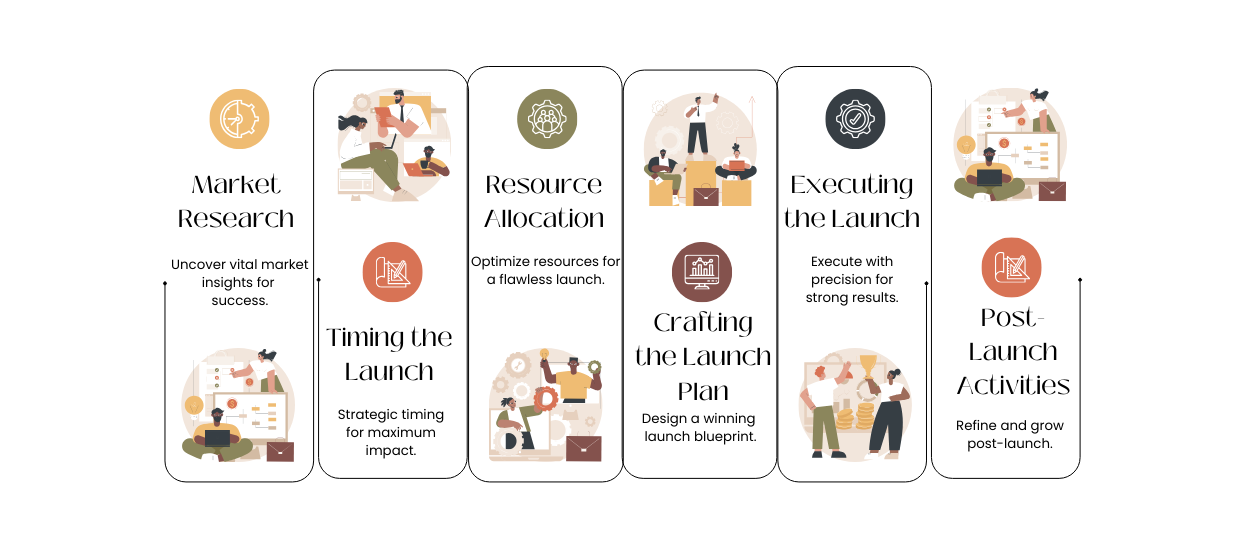A Perfect Product Launch Plan

Launching a product is a significant milestone for any company, marking the culmination of months or even years of hard work and preparation. A successful product launch can establish a brand, generate substantial revenue, and pave the way for future growth. However, achieving a successful launch requires careful planning and execution. This comprehensive guide explores the essential components of a successful product launch plan, including market research, timing, resource allocation, and post-launch activities.
Understanding Market Research
Why Market Research Matters
Market research is the cornerstone of any successful product launch. It provides critical insights into consumer needs, market trends, the competitive landscape, and potential challenges. Understanding these elements allows companies to tailor their products to meet market demands and position themselves effectively against competitors.
Types of Market Research
There are two main types of market research: primary and secondary.
- Primary Research: This involves collecting data directly from potential customers through methods like surveys, focus groups, or interviews. Primary research offers firsthand insights into consumer preferences, pain points, and behaviors.
- Secondary Research: This involves analyzing existing data from industry reports, competitor analysis, and market studies. Secondary research helps companies understand broader market trends and competitor strategies.
Executing Effective Market Research
To execute effective market research, companies should:
- Define Objectives: Clearly outline what you want to learn from your research. Are you trying to understand consumer behavior, assess market demand, or analyze competitors?
- Choose the Right Methods: Depending on your objectives, select appropriate research methods. Surveys and focus groups are excellent for qualitative data, while data analytics can provide quantitative insights.
- Analyze and Interpret Data: Analyze the data collected to identify key insights. Look for patterns and trends that can inform product development and marketing strategies.
- Apply Insights: Use the insights gained to refine product features, pricing, positioning, and marketing strategies.
Timing the Launch
The Importance of Timing
Timing is a crucial factor that can make or break a product launch. Launching too early might result in releasing an underdeveloped product, while launching too late can lead to missed market opportunities or increased competition.
Factors to Consider
When determining the best time to launch a product, consider the following factors:
- Market Conditions: Assess the current state of the market. Is there high demand for your product category? Are there seasonal trends that could impact your launch?
- Competitor Activity: Monitor competitors’ activities. Avoid launching your product too close to a competitor’s launch to prevent your efforts from being overshadowed.
- Internal Readiness: Ensure that your company is fully prepared for the launch, including having sufficient inventory, a trained sales team, and a well-coordinated marketing plan.
- Customer Readiness: Consider your target audience’s readiness. Have you created enough anticipation and interest?
Strategic Timing Approaches
There are different strategies for timing your launch:
- Soft Launch: A soft launch involves releasing the product to a limited audience before a broader release. This allows you to gather feedback and make adjustments before the full launch.
- Hard Launch: A hard launch is a full-scale release to the entire target market. This approach requires thorough preparation and confidence in your product’s readiness.
- Seasonal Launch: Some products perform better when launched during specific seasons. For example, fitness products may see higher demand at the start of the new year when people are setting health goals.
Resource Allocation
Budgeting for Success
A well-planned budget is crucial for a successful product launch. It ensures that you have the necessary resources to support all aspects of the launch, from product development to marketing and distribution.
Key Budget Considerations
- Product Development: Allocate funds for finalizing product design, testing, and production. Ensure that you have the necessary resources to meet demand without overproducing.
- Marketing and Advertising: A significant portion of your budget should be dedicated to marketing and advertising, including digital marketing, content creation, social media, and public relations efforts.
- Sales and Distribution: Consider costs associated with sales and distribution, including sales team training, distribution logistics, and retail partnerships.
- Customer Support: Allocate resources for customer support, especially if your product requires ongoing customer service or technical support.
Optimizing Resource Allocation
To optimize resource allocation, consider:
- Prioritizing High-Impact Activities: Focus on activities that will have the most significant impact on your launch, such as influencer marketing or targeted digital campaigns.
- Leveraging Partnerships: Collaborate with partners, influencers, or other brands to extend your reach and reduce costs. Partnerships can provide valuable exposure and credibility.
- Monitoring and Adjusting: Continuously monitor your budget and adjust as needed. Be prepared to reallocate funds to areas that are performing well or need additional support.
Crafting the Launch Plan
Setting Clear Objectives
A successful launch plan starts with clear objectives. What do you want to achieve with this launch? Objectives might include specific sales targets, brand awareness goals, or market penetration metrics. Having clear objectives will guide your strategy and help measure success.
Developing a Messaging Strategy
Your messaging strategy should communicate the value of your product and differentiate it from competitors. This includes:
- Unique Selling Proposition (USP): Clearly define what makes your product unique and why customers should choose it.
- Key Messages: Develop key messages that highlight the benefits and features of your product. These messages should be consistent across all marketing channels.
- Target Audience: Tailor your messaging to resonate with your target audience, considering their needs, preferences, and pain points.
Creating a Marketing Plan
Your marketing plan should outline the tactics and channels you’ll use to promote your product. This includes:
- Digital Marketing: Utilize digital channels such as social media, email marketing, and content marketing to reach your audience. Create engaging content that educates and excites potential customers.
- Public Relations: Leverage public relations to generate buzz and media coverage through press releases, media outreach, and influencer partnerships.
- Promotions and Incentives: Offer promotions, discounts, or incentives to encourage early adoption and drive initial sales.
Executing the Launch
Execution is critical. Ensure that all teams are aligned and prepared for the launch. This includes:
- Training and Communication: Train your sales and customer support teams to ensure they are knowledgeable about the product and ready to assist customers.
- Coordinating Efforts: Coordinate efforts across marketing, sales, and distribution to ensure a seamless launch experience.
- Monitoring and Adjusting: Monitor the launch in real-time and be prepared to make adjustments based on feedback and performance metrics.
Post-Launch Activities
Collecting and Analyzing Feedback
After the launch, collect feedback from customers, sales teams, and other stakeholders. Analyze this feedback to identify areas for improvement and understand customer satisfaction levels.
Iterating and Improving
Use the feedback collected to make necessary adjustments to the product, marketing strategies, or customer support processes. Continuous improvement is key to maintaining customer satisfaction and achieving long-term success.
Celebrating Success and Acknowledging Efforts
Take the time to celebrate the success of the launch with your team. Acknowledge the hard work and contributions of all involved. Celebrating success boosts team morale and sets a positive tone for future projects.
Leveraging Technology for Launch Success
CRM Integration
Integrate your launch activities with your Customer Relationship Management (CRM) system to manage leads, track customer interactions, and measure campaign effectiveness.
Marketing Automation
Utilize marketing automation platforms to automate email campaigns, social media, and other marketing tasks, saving time and resources.
Analytics Tools
Leverage analytics platforms to track website traffic, user behavior, and campaign performance, providing valuable insights for optimizing your strategy.
Product Launch Platforms
Consider using specialized product launch platforms to manage your launch process, including pre-launch buzz, crowdfunding, and early adopter engagement.
Common Launch Challenges and Solutions
Launching a new product can present various challenges. Here are some common obstacles and potential solutions:
- Delayed Product Development: Set realistic timelines for product development and allocate sufficient resources to avoid delays.
- Insufficient Marketing Budget: Prioritize essential marketing activities and explore cost-effective channels like social media and content marketing.
- Lack of Product-Market Fit: Conduct thorough market research and user testing before launch to validate product-market fit.
- Competition: Analyze competitors’ strengths and weaknesses to identify your unique selling proposition.
- Supply Chain Issues: Build strong relationships with suppliers and have contingency plans in place to address potential disruptions.
Leveraging the Power of Partnerships
Strategic partnerships can significantly amplify your product’s reach and accelerate growth. Here’s how to leverage them effectively:
- Identify Potential Partners: Research companies or organizations that align with your product’s target market and values.
- Build Strong Relationships: Establish connections with key decision-makers at potential partner organizations.
- Create Mutually Beneficial Partnerships: Develop partnerships that offer value to both parties, such as co-marketing campaigns, joint product development, or channel partnerships.
- Measure Partnership Performance: Track key metrics to assess the effectiveness of your partnerships and make necessary adjustments.
Conclusion
A successful product launch requires meticulous planning, execution, and adaptability. By following the outlined steps and leveraging strategic partnerships, you can increase your chances of success. Remember, a successful launch is not just about the initial excitement but also about building a strong foundation for long-term growth. Continuously gather feedback, analyze performance metrics, and iterate on your product to ensure its ongoing success.
Product Launch & Conquer: Downloadable Product Launch & Adoption Checklist
Launch with confidence & drive adoption! This FREE downloadable checklist empowers you to navigate the product launch & adoption phase seamlessly. Ensure a successful launch and user engagement with:
34+ Actionable Deliverables: A complete roadmap for your launch & user adoption strategy, covering all key aspects.





